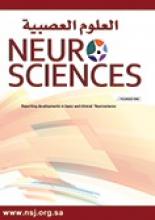Abstract
Objectives: To determine whether body size in different age periods is associated with an increased risk of MS in Saudi Arabia.
Methods: This study included 307 MS patients and 307 healthy controls from clinics and hospital wards in three cities (Riyadh, Jeddah, and Dammam) in Saudi Arabia (2016-2017). We used Stunkard’s standard body silhouettes to determine the participants’ body sizes (from 1 to 9) during different age periods (school levels). We calculated adjusted odds ratios (AORs) and 95% confidence intervals (CIs) and performed multivariable analysis adjusted for age and gender.
Results: Large body sizes (silhouettes 6–9) and body size 5 during intermediate school were associated with an increased risk of MS (AOR: 3.75, 95% CI: 1.10–12.78 and AOR: 3.75, 95% CI: 1.41–10, respectively). The smallest body size (1) during intermediate school was associated with a lower risk of MS (AOR: 0.39, 95% CI: 0.17–0.90) compared to body size 3.
Conclusion: Overweight and obesity during the intermediate school period (ages 13–15 years) are associated with an increased risk of MS, particularly among females.
Footnotes
Disclosure. This study was funded in part by a grant from MENACTRIMS and by Sanofi-Aventis Group, DMCC branch, of Sanofi-Aventis Group SA.
- Received September 19, 2021.
- Accepted April 7, 2022.
- Copyright: © Neurosciences
Neurosciences is an Open Access journal and articles published are distributed under the terms of the Creative Commons Attribution-NonCommercial License (CC BY-NC). Readers may copy, distribute, and display the work for non-commercial purposes with the proper citation of the original work.






